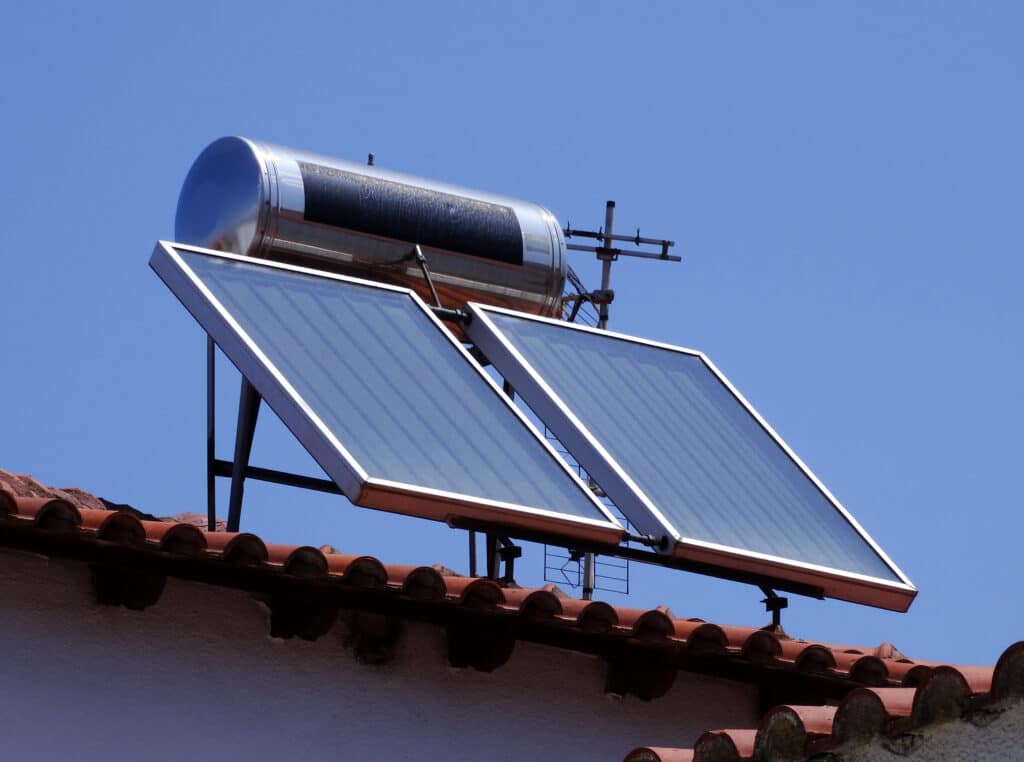
Integrating Solar Water Heating Systems
Tired of skyrocketing energy bills and looking for a greener way to heat your water? Solar water heating might be the perfect solution for you!
This blog will dive into everything you need to know about solar water heating, from how it works to its benefits. Let’s explore how harnessing the power of the sun can keep your showers hot and your wallet happy.

Photo from iStock – Credit: ruttipics
What is Solar Water Heating?
Solar water heating is a simple and effective way to use renewable energy to keep your showers warm and your dishes clean. Imagine waking up to a nice, hot shower, knowing that it’s all thanks to the sun!
Solar water heating systems have been around for quite some time. In fact, the idea dates back to the late 19th century. Back then, people used simple systems to harness the sun’s energy.
These systems have evolved significantly since then, becoming more efficient and accessible. Today, they are a popular choice for homeowners looking to save on energy costs and reduce their carbon footprint.
Solar water heating works by capturing sunlight and converting it into heat. This heat is then used to warm up water for your home.
The system includes solar collectors, usually placed on your roof, which absorb the sun’s rays. This energy is transferred to a storage tank where the water is heated and kept until you need it.
How Solar Water Heating Systems Work
Solar Collectors and Their Functions
First, it all starts with solar collectors. These are usually panels installed on your roof that catch sunlight.
Think of them as sun-catchers that absorb the sun’s energy and turn it into heat. There are different types of collectors, but they all serve the same purpose: soaking up those rays.
The Role of Heat Exchangers and Storage Tanks
Once the sunlight is captured, the heat needs to be transferred to your water. This is where heat exchangers come in.
Heat exchangers are like middlemen, transferring the heat from the collectors to the water in your storage tank. The storage tank is where your hot water is kept until you’re ready to use it.
The Importance of Controller Systems
To ensure everything runs smoothly, controller systems are used. These smart-systems monitor temperatures and make sure the heat is effectively moved from the collectors to the storage tank.
They also keep the system from overheating or freezing, which is crucial for maintaining efficiency. Without these controllers, the system wouldn’t be as reliable or efficient.
Backup Heaters and Their Necessity
Sometimes, the sun might not provide enough heat, especially on cloudy days or during winter. This is where backup heaters come into play. These heaters, which can be electric or gas, kick in when the solar system can’t meet your hot water needs on its own.
This ensures you always have hot water, no matter the weather. Backup heaters act as a safety net, ensuring continuous hot water supply.
Types of Solar Water Heating Systems
When it comes to solar water heating systems, there are different types to consider, each with its own advantages and suitable applications. Let’s explore these variations to help you understand which one might be best for your needs.
Direct vs. Indirect Systems
Direct systems heat the water directly in the solar collectors. Water flows through the collectors, gets heated by the sun, and then goes straight to your storage tank or tap. This system is ideal for areas where the water doesn’t freeze, as it can be vulnerable to freezing temperatures.
Indirect systems use a heat-transfer fluid that absorbs heat from the collectors. The heat-transfer fluid then transfers the heat to the water through a heat exchanger. This type is better suited for colder climates because the heat-transfer fluid is usually antifreeze, preventing the system from freezing.
Active vs. Passive Systems
Active systems rely on electric pumps, valves, and controllers to circulate the water or heat-transfer fluid through the system. They are more efficient and can be controlled more precisely, but are more complex and typically cost more to install and maintain.
Passive systems rely on natural convection or gravity to circulate water or heat-transfer fluid. They are simpler and usually more reliable since they have fewer moving parts. Generally, they are less expensive to install and maintain but might not be as efficient as active systems.
Understanding these different types of solar water heating systems can help you make an informed decision based on your climate, budget, and specific needs.
Components of Solar Water Heating Systems
Flat Plate Collectors vs. Evacuated Tube Collectors
Flat plate collectors are the most common type of solar collectors. They consist of a flat, insulated box with a dark absorber plate and a glass or plastic cover. These collectors are efficient, durable, and suitable for most residential applications.
On the other hand, evacuated tube collectors consist of multiple glass tubes with a vacuum between them, which reduces heat loss.
Each tube contains a heat pipe that transfers the absorbed heat to a manifold. These collectors are more efficient than flat plate collectors, especially in colder climates, but they are also more expensive.
Transfer Fluids: Antifreeze vs. Potable Water
Antifreeze is used in indirect solar water heating systems to prevent freezing. It is commonly glycol-based, ensuring the system operates even in cold temperatures. However, it requires regular maintenance to check and replace the fluid as needed.
Potable water is used in direct solar water heating systems. The water that flows through the collectors is the same water that ends up in your taps. This is a simpler system with less maintenance, but it is not suitable for areas with freezing temperatures.
Installation Process of Solar Water Heating Systems
Site Assessment and System Design
The first step in installing a solar water heating system is a thorough site assessment. This involves evaluating your roof’s orientation, angle, and shading to determine the best location for the solar collectors. An ideal site maximizes exposure to sunlight, which is essential for optimal performance.
Based on the site assessment, a tailored system design is created. This design considers your household’s hot water needs, the local climate, and the type of system best suited for your home. Proper design ensures the system will meet your hot water requirements efficiently.
Steps in the Installation Process
Once the design is finalized, the installation process begins. Here are the main steps involved:
- Mounting the Solar Collectors: The collectors are securely mounted on your roof at the optimal angle to capture the most sunlight.
- Installing the Heat Exchanger and Storage Tank: The heat exchanger and storage tank are typically placed in a convenient location within your home, such as a utility room or basement.
- Connecting the System Components: Pipes and valves are installed to connect the collectors, heat exchanger, and storage tank. This includes installing the controller system to monitor and manage the flow of heat.
- Adding the Backup Heater: If necessary, a backup heater is integrated into the system to ensure a continuous supply of hot water during less sunny periods.
- Testing and Commissioning: The entire system is thoroughly tested to ensure it operates correctly. This includes checking for leaks, verifying the functionality of the controller system, and ensuring the backup heater works as intended.
Common Challenges and Solutions
Installing a solar water heating system can come with a few challenges. One common issue is roof compatibility; not all roofs are suitable for mounting solar collectors. In such cases, ground-mounted systems or custom mounting solutions can be considered.
Another challenge is ensuring proper integration with your existing plumbing and heating systems. Skilled installers will carefully plan and execute the installation to minimize disruptions and ensure seamless operation.

Photo from iStock – Credit: Stefan Simonovski
Benefits of Solar Water Heating Systems
Environmental Benefits: Reducing Carbon Footprint
One of the most significant benefits of using the sun to heat your water is its positive impact on the environment. By harnessing the sun’s energy, you reduce your reliance on fossil fuels, which in turn lowers greenhouse gas emissions.
This reduction in carbon footprint helps combat climate change and promotes a healthier planet. Plus, using renewable energy means you are contributing to a more sustainable future.
Economic Benefits: Saving on Energy Bills
Another major advantage is the potential savings on your energy bills. While the initial installation cost can be high, the long-term savings often outweigh this expense.
Once installed, the system uses free solar energy to heat your water, which can significantly reduce your monthly energy costs. In some cases, homeowners can save up to 70% on their water heating bills.
Additionally, many regions offer financial incentives, such as tax credits or rebates, for installing these systems. These incentives can help offset the initial investment, making the switch even more cost-effective.
Efficiency and Reliability
Solar water heating systems are known for their efficiency and reliability. Modern systems are designed to capture and convert sunlight into heat with minimal energy loss.
Even on cloudy days, the system can still produce hot water, thanks to its ability to store excess heat. Moreover, the inclusion of backup heaters ensures you always have hot water, regardless of weather conditions.
Reliability is also a key feature of solar water heating systems. With fewer moving parts compared to traditional heating systems, they require less maintenance and have a longer lifespan. This means fewer repairs and replacements over time, providing peace of mind and consistent performance.
Choosing the Right Solar Water Heating System
Factors to Consider: Climate, Household Needs, and Budget
The climate of your area plays a significant role in determining the best system. For instance, if you live in a place with frequent freezing temperatures, an indirect system with antifreeze might be more suitable. On the other hand, warmer climates can benefit from direct systems.
Assessing your household’s hot water demand is also crucial. Larger households with higher hot water usage may require a more robust system with larger collectors and storage tanks.
Additionally, consider your budget, as the initial installation costs can vary. While some systems might be more expensive upfront, they can offer greater savings in the long run.
Comparing Different Systems
When comparing different systems, look at the efficiency, durability, and maintenance requirements. Flat plate collectors are durable and efficient for most homes, while evacuated tube collectors offer higher efficiency, especially in colder climates.
Active systems provide more control and efficiency but are more complex and costly. Passive systems, although less efficient, are simpler and more reliable with fewer components that can fail.
Maintenance and Troubleshooting
Regular Maintenance Tips
Regularly inspect the collectors for dirt, debris, or shading that might reduce efficiency. Keeping the collectors clean ensures they can absorb maximum sunlight.
Check the system’s fluid levels and pressure, and ensure there are no leaks in the pipes or connections. It’s also a good idea to have a professional check the system annually to ensure everything is working correctly and to address any potential issues before they become serious problems.
Common Issues and Solutions
Common issues include leaks, malfunctioning pumps, or a drop in system efficiency. If you notice a decrease in hot water production, it might be due to dirty collectors or a failing heat exchanger.
In such cases, cleaning the collectors or replacing faulty parts can resolve the issue and restore efficiency. If the backup heater is frequently running, it might indicate a problem with the solar collectors or heat exchanger that needs to be addressed promptly.
When to Call a Professional
If you encounter issues that you cannot resolve on your own, or if you’re unsure about performing maintenance tasks, it’s best to call a professional.
Regular professional maintenance can help identify and fix potential problems before they become major issues, ensuring your system remains efficient and reliable.
Professionals have the expertise to handle complex repairs and can provide valuable advice on optimizing your system. Don’t hesitate to seek professional help to keep your solar water heating system in top condition.
Comparing Solar Water Heaters to Conventional Systems
Solar vs. Gas and Electric Water Heaters
Solar water heaters use renewable energy from the sun, significantly reducing your reliance on fossil fuels and lowering your carbon footprint. By capturing and converting sunlight into heat, these systems provide an eco-friendly solution for your hot water needs.
Gas and electric heaters, while often cheaper to install initially, have higher operating costs over time. Additionally, these conventional systems contribute to greenhouse gas emissions, which can negatively impact the environment.
Pros and Cons of Each System
Solar heaters offer substantial long-term savings due to their low operating costs and the availability of sunlight as a free energy source. They also provide significant environmental benefits, helping to reduce your home’s carbon footprint.
However, solar heaters come with higher upfront costs and depend on sunlight availability, which can be a limitation in less sunny climates.
Gas and electric heaters, on the other hand, are less expensive to install and can provide consistent hot water regardless of the weather, making them a reliable choice. Despite their reliability, they are more costly to operate over time and less eco-friendly due to their reliance on fossil fuels.
Ready to Go Green with Tioga Plumbing & Electric?
Are you ready to reduce your energy bills and help the environment? Tioga Plumbing & Electric is here to provide top-notch solar water heating systems for your home in Bedford, Euless, or Grapevine, TX.
Our expert team ensures a smooth installation and reliable maintenance, giving you peace of mind and long-term savings.
Don’t wait to make the switch to a more sustainable, cost-effective energy solution. Contact Tioga Plumbing & Electric today at (682) 224-0757 and let us help you harness the power of the sun!
FAQ
What happens on cloudy days?
On cloudy days, the system may produce less hot water, but it typically has a backup heater to ensure a continuous supply. This ensures that you have hot water available even when the sun isn’t shining brightly.
How much roof space is needed?
The required roof space depends on the size of the system and your hot water needs. Generally, a typical system requires around 40 to 60 square feet of roof space. Ensuring adequate space is essential for optimal performance.
Can a solar water heating system work in cold climates?
Yes, indirect systems with antifreeze can work efficiently in cold climates, preventing the system from freezing. These systems are designed to handle low temperatures and continue providing hot water even in winter.
Is professional installation necessary?
Professional installation is recommended to ensure the system is correctly installed and optimized for maximum efficiency. Expert installers can address specific challenges and ensure the system operates reliably.
How long does a solar water heating system last?
With proper maintenance, these systems can last 20 years or more, making them a long-term investment. Regular inspections and upkeep can extend the system’s lifespan and maintain its efficiency.


